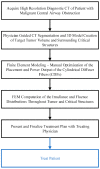Devices and Methods for Dosimetry of Personalized Photodynamic Therapy of Tumors: A Review on Recent Trends
- PMID: 39001546
- PMCID: PMC11240380
- DOI: 10.3390/cancers16132484
Devices and Methods for Dosimetry of Personalized Photodynamic Therapy of Tumors: A Review on Recent Trends
Abstract
Significance: Despite the widespread use of photodynamic therapy in clinical practice, there is a lack of personalized methods for assessing the sufficiency of photodynamic exposure on tumors, depending on tissue parameters that change during light irradiation. This can lead to different treatment results. Aim: The objective of this article was to conduct a comprehensive review of devices and methods employed for the implicit dosimetric monitoring of personalized photodynamic therapy for tumors. Methods: The review included 88 peer-reviewed research articles published between January 2010 and April 2024 that employed implicit monitoring methods, such as fluorescence imaging and diffuse reflectance spectroscopy. Additionally, it encompassed computer modeling methods that are most often and successfully used in preclinical and clinical practice to predict treatment outcomes. The Internet search engine Google Scholar and the Scopus database were used to search the literature for relevant articles. Results: The review analyzed and compared the results of 88 peer-reviewed research articles presenting various methods of implicit dosimetry during photodynamic therapy. The most prominent wavelengths for PDT are in the visible and near-infrared spectral range such as 405, 630, 660, and 690 nm. Conclusions: The problem of developing an accurate, reliable, and easily implemented dosimetry method for photodynamic therapy remains a current problem, since determining the effective light dose for a specific tumor is a decisive factor in achieving a positive treatment outcome.
Keywords: computer modeling; diffuse reflectance spectroscopy; fluorescence imaging; fluorescent diagnostics; optical spectroscopy; photodynamic dosimetry; photodynamic therapy.
Conflict of interest statement
The authors declare no conflicts of interest.
Figures












References
-
- Gierlich P., Donohoe C., Behan K., Kelly D.J., Senge M.O., Gomes-da-Silva L.C. Antitumor Immunity Mediated by Photodynamic Therapy Using Injectable Chitosan Hydrogels for Intratumoral and Sustained Drug Delivery. Biomacromolecules. 2023;25:24–42. doi: 10.1021/acs.biomac.3c00591. - DOI - PMC - PubMed
-
- Sun X., Cao Z., Mao K., Wu C., Chen H., Wang J., Wang X., Cong X., Li Y., Meng X. Photodynamic Therapy Produces Enhanced Efficacy of Antitumor Immunotherapy by Simultaneously Inducing Intratumoral Release of Sorafenib. Biomaterials. 2020;240:119845. doi: 10.1016/j.biomaterials.2020.119845. - DOI - PubMed
Publication types
Grants and funding
LinkOut - more resources
Full Text Sources
Miscellaneous

